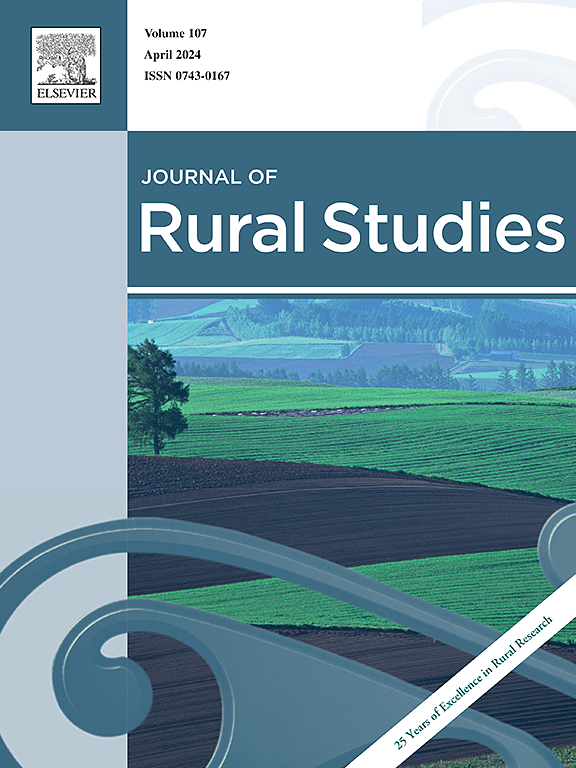Socio-technical networks in rural contexts: Analysing shearing schedules and functioning in Patagonian sheep farming
IF 5.1
1区 社会学
Q1 GEOGRAPHY
引用次数: 0
Abstract
The interaction between farmers and rural contractors enhances the efficiency of agricultural processes. The seasonality of agricultural activities concentrates rural contractors work during specific time windows and requires detailed scheduling. In this article, we propose a socio-technical network perspective to study the shearing processes on wool production in Northern Patagonia, Argentina. We analysed the functioning of socio-technical shearing networks (STSN), consisting of farmers and shearing contractors, throughout the development of their work schedules. Data were collected from wool shearing records and semi-structured interviews with shearing contractors, and principal component analysis were performed to characterize the STSN. The analysis of STSN highlighted two main socio-technical configurations based on shearing capacity and farm production scale. The first corresponded to shearing contractors with lower shearing capacities and a higher proportion of small-scale sheep farming farms, developing shearing schedules with lower work volumes. The second consisted of shearing contractors with higher shearing capacities and sheep farming farms of varying production scales, developing shearing schedules with higher work volumes. However, similar socio-technical configurations did not always result in identical functioning. While some prioritised efficiency by maximizing work volume in fewer farms with shorter travel times, others adapted to wider temporal and geographical scopes. This highlights the complex interplay between socio-technical configurations and performance outcomes in scheduling implementation. It reflects different underlying economic and work strategies in applying technological practices within specific social and environmental contexts. STSN illustrated how harvesting processes can be understood through a more complex perspective than mere practice, integrating social actors during technology application.
社会技术网络在农村环境:分析剪羊毛时间表和功能在巴塔哥尼亚羊养殖业
农民和农村承包者之间的互动提高了农业生产过程的效率。农业活动的季节性使农村承包者在特定的时间窗口内工作,需要详细的安排。在本文中,我们提出了一个社会技术网络的角度来研究阿根廷北部巴塔哥尼亚羊毛生产的剪切过程。我们分析了社会技术剪羊毛网络(STSN)的功能,包括农民和剪羊毛承包商,在他们工作时间表的整个发展过程中。数据收集自羊毛剪切记录和与剪切承包商的半结构化访谈,并进行主成分分析以表征STSN。对STSN的分析突出了基于剪切能力和农场生产规模的两种主要社会技术配置。第一种是剪羊毛承包商,剪羊毛能力较低,小规模羊养殖场比例较高,制定剪羊毛时间表,工作量较低。第二组由具有较高剪剪能力的剪剪承包商和不同生产规模的养羊场组成,制定了较高工作量的剪剪时间表。然而,相似的社会技术结构并不总是导致相同的功能。有些人优先考虑在更少的农场和更短的旅行时间内最大限度地提高工作量,而另一些人则适应更广泛的时间和地理范围。这突出了在调度实施中社会技术配置和性能结果之间复杂的相互作用。它反映了在特定社会和环境背景下应用技术实践的不同基本经济和工作战略。STSN说明了如何通过更复杂的角度来理解收获过程,而不仅仅是实践,在技术应用过程中整合社会行动者。
本文章由计算机程序翻译,如有差异,请以英文原文为准。
求助全文
约1分钟内获得全文
求助全文
来源期刊

Journal of Rural Studies
Multiple-
CiteScore
9.80
自引率
9.80%
发文量
286
期刊介绍:
The Journal of Rural Studies publishes research articles relating to such rural issues as society, demography, housing, employment, transport, services, land-use, recreation, agriculture and conservation. The focus is on those areas encompassing extensive land-use, with small-scale and diffuse settlement patterns and communities linked into the surrounding landscape and milieux. Particular emphasis will be given to aspects of planning policy and management. The journal is international and interdisciplinary in scope and content.
 求助内容:
求助内容: 应助结果提醒方式:
应助结果提醒方式:


